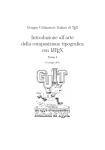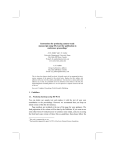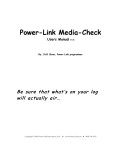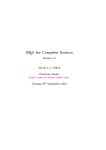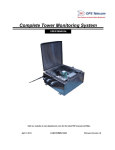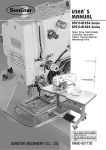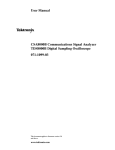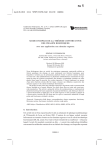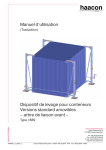Download pdf file
Transcript
June 12, 2006 14:27 WSPC - Proceedings Trim Size: 9in x 6in ws-procs9x6 1 FOR PROCEEDINGS CONTRIBUTORS: USING WORLD SCIENTIFIC’S WS-PROCS9X6 DOCUMENT CLASS IN LATEX2e A. B. AUTHOR∗ and C. D. AUTHOR University Department, University Name, City, State ZIP/Zone, Country ∗ E-mail: ab [email protected] www.university name.edu A. N. AUTHOR Group, Laboratory, Street, City, State ZIP/Zone, Country E-mail: an [email protected] This article explains how to use World Scientific’s ws-procs9x6 document class written in LATEX2e. This article was typeset using ws-procs9x6.cls and may be used as a template for your contribution. Keywords: Style file; LATEX; Proceedings; World Scientific Publishing. 1. Using Other Packages The class file loads the packages amsfonts, amsmath, amssymb, chapterbib, cite, dcolumn, epsfig, rotating and url at startup. Please try to limit your use of additional packages as they often introduce incompatibilities. This problem is not specific to the WSPC styles; it is a general LATEX problem. Check this article to see whether the required functionality is already provided by the WSPC class file. If you do need additional packages, send them along with the paper. In general, you should use standard LATEX commands as much as possible. 2. Layout In order to facilitate our processing of your article, please give easily identifiable structure to the various parts of the text by making use of the usual LATEX commands or by using your own commands defined in June 12, 2006 14:27 WSPC - Proceedings Trim Size: 9in x 6in ws-procs9x6 2 the preamble, rather than by using explicit layout commands, such as \hspace, \vspace, \large, \centering, etc. Also, do not redefine the page-layout parameters. For more information on layout and font specifications, please refer to our Layout and Font Specification Guide. 3. User Defined Macros User defined macros should be placed in the preamble of the article, and not at any other place in the document. Such private definitions, i.e. definitions made using the commands \newcommand, \renewcommand, \newenvironment or \renewenvironment, should be used with great care. Sensible, restricted usage of private definitions is encouraged. Large macro packages and definitions that are not used in this example article should be avoided. Please do not change the existing environments, commands and other standard parts of LATEX. 4. Using WS-procs9x6 You can obtain these files from the following website: http: //eproceedings.worldscinet.com/authors.shtml, http://www.wspc. com.sg/style/proceedings_style.shtml and http://www.icpress.co. uk/authors/stylefiles.shtml#proceedings. 4.1. Input used to produce this paper \documentclass{ws-procs9x6} \begin{document} \title{FOR PROCEEDINGS CONTRIBUTORS: ...} \author{A. B. AUTHOR$^*$ and C. D. AUTHOR} \address{University Department, ...} \begin{abstract} This article explains how to ... \end{abstract} \keywords{Style file; \LaTeX, ...} \bodymatter \section{Using Other Packages} The class file has ... \bibliographystyle{ws-procs9x6} \bibliography{ws-pro-sample} \end{document} June 12, 2006 14:27 WSPC - Proceedings Trim Size: 9in x 6in ws-procs9x6 3 5. Sectional Units Sectional units are obtained in the usual way, i.e. with the LATEX commands \section, \subsection, \subsubsection and \paragraph. 6. Section This is just an example. 6.1. Subsection This is just an example. 6.1.1. Subsubsection This is just an example. Paragraph This is just an example. Unnumbered Section Unnumbered sections can be obtained by using \section*. 7. Lists of Items Lists are broadly classified into four major categories that can randomly be used as desired by the author: (a) (b) (c) (d) Numbered list. Lettered list. Unnumbered list. Bulleted list. 7.1. Numbered and lettered list (1) The \begin{arabiclist}[] command is used for the arabic number list (arabic numbers appearing within parenthesis), e.g., (1), (2), etc. (2) The \begin{romanlist}[] command is used for the roman number list (roman numbers appearing within parenthesis), e.g., (i), (ii), etc. (3) The \begin{Romanlist}[] command is used for the cap roman number list (cap roman numbers appearing within parenthesis), e.g., (I), (II), etc. June 12, 2006 14:27 WSPC - Proceedings Trim Size: 9in x 6in ws-procs9x6 4 (4) The \begin{alphlist}[] command is used for the alphabetic list (alphabets appearing within parenthesis), e.g., (a), (b), etc. (5) The \begin{Alphlist}[] command is used for the cap alphabetic list (cap alphabets appearing within parenthesis), e.g., (A), (B), etc. Note: For all the above mentioned lists (with the exception of alphabetic list), it is obligatory to enter the last entry’s number in the list within the square bracket, to enable unit alignment. 7.2. Bulleted and unnumbered list The \begin{itemlist} command is used for the bulleted list. The \begin{unnumlist} command is used for creating the unnumbered list with the turnovers hangindent by 1 pica. Lists may be laid out with each item marked by a dot: • item one • item two • item three. Items may also be numbered with lowercase Roman numerals: (i) item one (ii) item two (a) lists within lists can be numbered with lowercase Roman letters (b) second item. (iii) item three (iv) item four. 8. Theorems and Definitions Input: \begin{theorem} We have $\# H^2 (M \supset N) < \infty$ for an inclusion ... \end{theorem} Output: Theorem 8.1. We have #H 2 (M ⊃ N ) < ∞ for an inclusion M ⊃ N of factors of finite index. June 12, 2006 14:27 WSPC - Proceedings Trim Size: 9in x 6in ws-procs9x6 5 Input: \begin{theorem}[Longo, 1998] For a given $Q$-system... \[ N = \{x \in N; T x = \gamma (x) T, T x^* = \gamma (x^*) T\}, \] and $E_\Xi (\cdot) = T^* \gamma (\cdot) T$ gives ... \end{theorem} Output: Theorem 8.2 (Longo, 1998). For a given Q-system... N = {x ∈ N ; T x = γ(x)T, T x∗ = γ(x∗ )T }, and EΞ (·) = T ∗ γ(·)T gives a conditional expectation onto N . The following environments are available by default with WSPC document styles: Environment Heading Sample output algorithm answer assertion assumption case claim comment condition conjecture convention corollary criterion definition example lemma notation note observation problem proposition question remark solution step summary theorem Algorithm Answer Assertion Assumption Case Claim Comment Condition Conjecture Convention Corollary Criterion Definition Example Lemma Notation Note Observation Problem Proposition Question Remark Solution Step Summary Theorem Algorithm 1.1. This is a test. Answer 1.1. This is a test. Assertion 1.1. This is a test. Assumption 1.1. This is a test. Case 1.1. This is a test. Claim 1.1. This is a test. Comment 1.1. This is a test. Condition 1.1. This is a test. Conjecture 1.1. This is a test. Convention 1.1. This is a test. Corollary 1.1. This is a test. Criterion 1.1. This is a test. Definition 1.1. This is a test. Example 1.1. This is a test. Lemma 1.1. This is a test. Notation 1.1. This is a test. Note 1.1. This is a test. Observation 1.1. This is a test. Problem 1.1. This is a test. Proposition 1.1. This is a test. Question 1.1. This is a test. Remark 1.1. This is a test. Solution 1.1. This is a test. Step 1.1. This is a test. Summary 1.1. This is a test. Theorem 1.1. This is a test. June 12, 2006 14:27 WSPC - Proceedings Trim Size: 9in x 6in ws-procs9x6 6 LATEX provides \newtheorem to create new theorem environments. To add theorem-type environments to an article, use \newtheorem{example}{Example}[section] \let\Examplefont\upshape \def\Exampleheadfont{\bfseries} \begin{example} We have $\# H^2 (M \supset N) < ... \end{example} For details see the LATEX user manual.1,2 8.1. Proofs The WSPC document styles also provide a predefined proof environment for proofs. The proof environment produces the heading ‘Proof’ with appropriate spacing and punctuation. It also appends a ‘Q.E.D.’ symbol, ¤, at the end of a proof, e.g., \begin{proof} This is just an example. \end{proof} to produce Proof. This is just an example. The proof environment takes an argument in curly braces, which allows you to substitute a different name for the standard ‘Proof’. If you want to display, ‘Proof of Lemma’, then write e.g. \begin{proof}[Proof of Lemma] This is just an example. \end{proof} produces Proof of Lemma. This is just an example. 9. Programs and Algorithms Fragments of computer programs and descriptions of algorithms should be prepared as if they were normal text. Use the same fonts for keywords, vari- June 12, 2006 14:27 WSPC - Proceedings Trim Size: 9in x 6in ws-procs9x6 7 ables, etc., as in the text; do not use small typeface sizes to make program fragments and algorithms fit within the margins set by the document style. An example with only the tabbing environment and one new definition: \newcommand{\keyw}[1]{{\bf #1}} \begin{tabbing} \quad \=\quad \=\quad \kill \keyw{for} each $x$ \keyw{do} \\ \> \keyw{if} extension$(p, x)$ \\ \> \> \keyw{then} $E:=E\cup\{x\}$\\ \keyw{return} $E$ \end{tabbing} Output: for each x do if extension(p, x) then E := E ∪ {x} return E 10. Mathematical Formulas Inline: For in-line formulas use \( ... \) or $ ... $. Avoid built-up constructions, for example fractions and matrices, in in-line formulas. Fractions in inline can be typed with a solidus, e.g. x+y/z=0. Display: For numbered display formulas, use the displaymath environment: \begin{equation} ... \label{aba:eqno} \end{equation} And for unnumbered display formulas, use \[ ... \]. For numbered displayed, one-line formulas always use the equation environment. Do not use $$ ... $$. June 12, 2006 14:27 WSPC - Proceedings Trim Size: 9in x 6in ws-procs9x6 8 For example, the input for: ∞ P µ(n, t) = i=1 1(di < t, N (di ) = n) Rt . (1) 1(N (σ) = n)dσ σ=0 is: \begin{equation} \mu(n, t) = \frac{\sum\limits^\infty_{i=1}1 (d_i < t, N(d_i) = n)} {\int\limits^t_{\sigma=0}1 (N(\sigma)=n)d\sigma}.\label{aba:eq1} \end{equation} For displayed multi-line formulas, use the eqnarray environment. For example, \begin{eqnarray} \zeta\mapsto\hat{\zeta}&=&a\zeta+b\eta\label{aba:appeq2}\\ \eta\mapsto\hat{\eta}&=&c\zeta+d\eta\label{aba:appeq3} \end{eqnarray} produces: ζ 7→ ζ̂ = aζ + bη (2) η 7→ η̂ = cζ + dη (3) Superscripts and subscripts that are words or abbreviations, as in σlow , should be typed as roman letters, with \(\sigma_{\mathrm{low}}\) instead of σlow done with \(\sigma_{low}\). For geometric functions, e.g. exp, sin, cos, tan, etc., please use the macros \sin, \cos, \tan. These macros give proper spacing in mathematical formulas. It is also possible to use the AMS-LATEX package,2 which can be obtained from the AMS and various TEX archives. 11. Floats 11.1. Tables Put tables and figures in text using the table and figure environments, and position them near the first reference of the table or figure in the text. Please avoid long captions in figures and tables. June 12, 2006 14:27 WSPC - Proceedings Trim Size: 9in x 6in ws-procs9x6 9 Input: \begin{table} \tbl{Comparison of acoustic for frequencies for piston-cylinder problem.} {\begin{tabular}{@{}cccc@{}}\toprule Piston mass & Analytical frequency & TRIA6-$S_1$ model & ...\\ & (Rad/s) & (Rad/s) \\\colrule 1.0\hphantom{00}&\hphantom{0}281.0&\hphantom{0}280.81&0.07 \\ 0.1\hphantom{00}&\hphantom{0}876.0&\hphantom{0}875.74&0.03 \\ 0.01\hphantom{0}&2441.0&2441.0\hphantom{0}&0.0\hphantom{0} \\ 0.001 & 4130.0 & 4129.3\hphantom{0}& 0.16\\\botrule \end{tabular}} \begin{tabnote} $^{\text a}$ Sample table footnote.\\ \end{tabnote}\label{aba:tbl1} \end{table} Output: Table 1. Comparison of acoustic for frequencies for piston-cylinder problem. Piston mass Analytical frequency (Rad/s) TRIA6-S1 model (Rad/s) % Errora 1.0 0.1 0.01 0.001 281.0 876.0 2441.0 4130.0 280.81 875.74 2441.0 4129.3 0.07 0.03 0.0 0.16 Note: a Sample table footnote. Very large figures and tables should be placed on a separate page by themselves. Landscape tables and figures can be typeset with the following environments: • sidewaystable and • sidewaysfigure. Example: \begin{sidewaystable} \tbl{Positive values of ...} 2 0.2 5 3 0.1 1 5 0.001 0.001 0.1 1 0.1 0.1 0.1 1 5 0.2 10 2 0.001 0.001 0.51 0.302 −0.301 0.2 0.1 0.333 −0.1 0.1 0.1 0.034 −0.033 α0 0.128192 0.089435 0.128966 0.089441 0.309739, 0.275856 0.316014, 0.41436 0.414324 0.169063, 0.414412 0.19718, 0.089409 — 0.414489 0.848544, — — 0.466499 — — — — 1.22434 2.44524, 7D 0.41436 0.089435 — 0.414412 0.91379, — — 0.466489 — — — — 1.1879 3.15991, 6D 0.414489 0.142103, 0.08935 — 0.414605 0.783787, — — 0.464947 — — — — 1.29065 1.92883, 8D — 0.089061 — 0.415056 0.669541, — — 0.45438 — — — — 0.415056 0.669541, 10D — 0.088347 — 0.416214 0.577489, — — 0.429651 — — — — — 12D — 0.084352 — — — — 0.35278 — — — — — 16D WSPC - Proceedings Trim Size: 9in x 6in 0.275327 0.968869, — — 0.996033, — — 0.465426 0.858211 0.463679 0.806578 — 1.1946 1.667, — 1.65625 — 1.48602 1.24003 2.07773, 1.72737, 3.15662, 4.32936, 1.16321 6.75507, 5D 1.14476 4D Positive roots (X0 ) 14:27 −0.5 λ0 f0 Table 2. Positive values of X0 by eliminating Q0 from Eqs. (15) and (16) for different values of the parameters f0 , λ0 and α0 in various dimension. June 12, 2006 ws-procs9x6 10 June 12, 2006 14:27 WSPC - Proceedings Trim Size: 9in x 6in ws-procs9x6 11 {\begin{tabular}{@{}ccccccccccc@{}} \toprule\\ $f_0$ &$\lambda_0$ &$\alpha_0$... \end{tabular}} \label{aba:tbl2} \end{sidewaystable} By using \tbl command in table environment, long captions will be justified to the table width while the short or single line captions are centered. \tbl{table caption}{tabullar environment}. For most tables, the horizontal rules are obtained by: toprule one rule at the top colrule one rule separating column heads from data cells botrule one bottom rule Hline one thick rule at the top and bottom of the tables with multiple column heads To avoid the rules sticking out at either end of the table, add @{} before the first and after the last descriptors, e.g. @llll@. Please avoid vertical rules in tables. But if you think the vertical rule is a must, you can use the standard LATEX tabular environment. Headings which span for more than one column should be set using \multicolumn{#1}{#2}{#3} where #1 is the number of columns to be spanned, #2 is the argument for the alignment of the column head which may be either c — for center alignment; l — for left alignment; or r — for right alignment, as desired by the users. Use c for column heads as this is the WS style and #3 is the heading. For the footnotes in the table environment the command is {\begin{tabnote}<text>\end{tabnote}}. Tables should have a uniform style throughout the proceedings volume. It does not matter how you place the inner lines of the table, but we would prefer the border lines to be of the style as shown in our sample tables. For the inner lines of the table, it looks better if they are kept to a minimum. 11.2. Figures The preferred graphics formats are TIF and Encapsulated PostScript (EPS) for any type of image. Our TEX installation requires EPS, but we can easily convert TIF to EPS. Many other formats, e.g. PICT (Macintosh), WMF (Windows) and various proprietary formats, are not suitable. Even if we June 12, 2006 14:27 WSPC - Proceedings Trim Size: 9in x 6in ws-procs9x6 12 can read such files, there is no guarantee that they will look the same on our systems as on yours. A figure is obtained with the following commands: \begin{figure} \psfig{file=procs-fig1.eps,width=4.5in} \caption{The bifurcating response curves of system $\alpha=0.5, \beta=1.8; \delta=0.2, \gamma=0$: (a) $\mu=-1.3$; and (b) $\mu=0.3$.} \label{aba:fig1} \end{figure} Caring for other people's needs A1 Achievement and target oriented 6 A21 A2 Polite/ courteous Decisive A20 Optimistic A19 5 A3 Conscientious and take care when doing work 4 A4 Control over emotion 3 Sociable A18 A5 Willing to adapt to or accept new/ different ideas/ situations 2 1 Critical A6 A17 Aggressive 0 Independent A7 Dedication to work A16 Confident A8 Interested & enthusiastic A15 Realistic A14 Risk taking A9 A13 A12 Instinctive Inventive A10 Principled A11 Investigative Benchmark Individual's Fig. 1. The bifurcating response curves of system α = 0.5, β = 1.8; δ = 0.2, γ = 0: (a) µ = −1.3; and (b) µ = 0.3. Adjust the scaling of the figure until it is correctly positioned, and remove the declarations of the lines and any anomalous spacing. 12. Cross-references Use \label and \ref for cross-references to equations, figures, tables, sections, subsections, etc., instead of plain numbers. Every numbered part to June 12, 2006 14:27 WSPC - Proceedings Trim Size: 9in x 6in ws-procs9x6 13 which one wants to refer, should be labeled with the instruction \label. For example: \begin{equation} \mu(n, t) = \frac{\sum\limits^\infty_{i=1}1 (d_i < t, N(d_i) = n)} {\int\limits^t_{\sigma=0}1 (N(\sigma)=n)d\sigma}.\label{aba:eq1} \end{equation} With the instruction \ref one can refer to a numbered part that has been labeled: ..., see also Eq. (\ref{aba:eq1}) The \label instruction should be typed • immediately after (or one line below), but not inside the argument of a number-generating instruction such as \section or \caption, e.g.: \caption{ ... caption ... }\label{aba:fig1}. • roughly in the position where the number appears, in environments such as an equation, • labels should be unique, e.g., equation 1 can be labeled as \label{aba:eq1}, where ‘aba’ is author’s initial and ‘eq1’ the equation number. Some useful shortcut commands. Shortcut command Equivalent TEX command Output In the middle of a sentence: \eref{aba:eq1} Eq. (\ref{aba:eq1}) \sref{aba:sec1} Sec. \ref{aba:sec1} \fref{aba:fig1} Fig. \ref{aba:fig1} \tref{aba:tbl1} Table \ref{aba:tbl1} Eq. (1) Sec. 1 Fig. 1 Table 1 At the starting of a sentence: \Eref{aba:eq1} Equation (\ref{aba:eq1}) \Sref{aba:sec1} Section \ref{aba:sec1} \Fref{aba:fig1} Figure \ref{aba:fig1} \Tref{aba:tbl1} Table \ref{aba:tbl1} Equation (1) Section 1 Figure 1 Table 1 13. Citations We have used \bibitem to produce the bibliography. Citations in the text use the labels defined in the bibitem declaration, e.g., the first paper by Jarlskog3 is cited using the command \cite{jarl88}. Bibitem labels should June 12, 2006 14:27 WSPC - Proceedings Trim Size: 9in x 6in ws-procs9x6 14 be unique. For multiple citations, do not use \cite{1}, \cite{2}, but use \cite{1,2} instead. When the reference forms part of the sentence, it should not be typed in superscripts, e.g.: “One can show from Ref. 3 that . . .”, “See Refs. 1 and 2 for more details.” This is done using the LATEX command: “Ref.~\refcite{name}”. 14. Footnotes Footnotes are denoted by a Roman letter superscript in the text. Footnotes can be used as Input: ... total.\footnote{Sample footnote text.} Output: ... in total.a 15. Acknowledgments and Appendices Acknowledgments to funding bodies etc. may be placed in a separate section at the end of the text, before the Appendices. This should not be numbered, so use \section*{Acknowledgments}. It is preferable to have no appendices in a short article, but if it is necessary, then simply use as \appendix{About the Appendix} Appendices should be... \begin{equation} \mu(n, t) = \frac{\sum^\infty_{i=1} 1(d_i < t, N(d_i) = n)} {\int^t_{\sigma=0} 1(N(\sigma) = n)d\sigma}. \label{aba:app1} \end{equation} \subappendix{Appendix Sectional Units} Sectional units are... 16. References References are to be listed in the order cited in the text in Arabic numerals. BIBTEX users, please use our bibliography style file ws-procs9x6.bst for a Sample footnote text. June 12, 2006 14:27 WSPC - Proceedings Trim Size: 9in x 6in ws-procs9x6 15 references. Non BIBTEX users can list down their references in the following pattern. \begin{thebibliography}{9} \bibitem{jarl88} C. Jarlskog, in {\it CP Violation} (World Scientific, Singapore, 1988). \bibitem{lamp94} L. Lamport, {\it \LaTeX, A Document Preparation System}, 2nd edition (Addison-Wesley, Reading, Massachusetts, 1994). \bibitem{ams04} \AmS-\LaTeX{} Version 2 User’s Guide (American Mathematical Society, Providence, 2004). \bibitem{best03} B.~W. Bestbury, {\em J. Phys. A} {\bf 36}, 1947 (2003). \end{thebibliography} 17. BIBTEXing Sample output using ws-procs9x6 bibliography style file: BIBTEX Database entry type article proceedings inproceedings book edition editor series tech report unpublished phd thesis masters thesis incollection misc Sample citation ... text.4–6 ... text.7 ... text.8 ... text.3,9 ... text.10 ... text.11 ... text.12 See Refs. 13 and 14 for more details ... text.15 ... text.16 ... text.17 ... text.18 ... text.19 If you use the BIBTEX program to maintain your bibliography, you do not use the thebibliography environment. Instead, you should include \bibliographystyle{ws-procs9x6} \bibliography{ws-pro-sample} June 12, 2006 14:27 WSPC - Proceedings Trim Size: 9in x 6in ws-procs9x6 16 where ws-procs9x6 refers to a file ws-procs9x6.bst, which defines how your references will look. The argument to \bibliography refers to the file ws-pro-sample.bib, which should contain your database in BIBTEX format. Only the entries referred to via \cite will be listed in the bibliography. Appendix A. About the Appendix Appendices should be used only when absolutely necessary. They should come before the References. Table A1. Macros available for tables/figures. Environment name Purpose figure sidewaysfigure table sidewaystable Figures Landscape figures Tables Landscape tables Horizantal rules Purpose \toprule \colrule One rule at the top One rule separating column heads from data cells One bottom rule One thick rule at the top and bottom of the tables with multiple column heads \botrule \Hline Number displayed equations occurring in the Appendix in this way, e.g. (A.1), (A.2), etc. ds2 = dt2 − a2i (A.1) Appendix A.1. Appendix Sectional Units Where two or more appendices are used, number them alphabetically. Sectional units are obtained with the LATEX commands: • \appendix • \subappendix. Unnumbered appendix sections can be obtained using \section*. June 12, 2006 14:27 WSPC - Proceedings Trim Size: 9in x 6in ws-procs9x6 17 Table A2. Macros available for use in text. Macro name Purpose \title{#1} \author{#1} \address{#1} \begin{abstract}...\end{abstract} \keywords{#1} \bodymatter \section{#1} \subsection{#1} \subsubsection{#1} \section*{#1} \begin{itemlist} \end{itemlist} \begin{arabiclist} \end{arabiclist} \begin{romanlist} \end{romanlist} \begin{Romanlist} \end{Romanlist} \begin{alphlist} \end{alphlist} \begin{Alphlist} \end{Alphlist} \begin{proof} \end{proof} \begin{theorem} \end{theorem} Article title List of all authors Address of author Abstract Keywords Start body text Section heading Subsection heading Subsubsection heading Unnumbered Section head Start bulleted lists End bulleted lists Start arabic lists (1, 2, 3...) End arabic lists Start roman lists (i, ii, iii...) End roman lists Start roman lists (I, II, III...) End roman lists Start alpha lists (a, b, c...) End alpha lists Start alpha lists (A, B, C...) End alpha lists Start of Proof End of Proof Start of Theorem End of Theorem (See Page 5 for list of other Math environments) Appendix Section heading Appendix Subsection heading Start of numbered reference list Reference item in numbered style End of numbered reference list To include BIBTEX style file To include BIBTEX database \appendix{#1} \subappendix{#1} \begin{thebibliography}{#1} \bibitem{#1} \end{thebibliography} \bibliographystyle{#1} \bibliography{#1} References 1. L. Lamport, LATEX, A Document Preparation System, 2nd edn. (AddisonWesley, Reading, MA, 1994). 2. AMS, AMS-LATEX Version 2 User’s Guide (American Mathematical Society, Providence, 2004). http://www.ams.org/tex/amslatex.html. 3. C. Jarlskog, CP Violation (World Scientific, Singapore, 1988). 4. B. W. Bestbury, J. Phys. A 36, 1947 (2003). 5. P. X. Deligne and B. H. Gross, C. R. Math. Acad. Sci. Paris 335, 877 (2002). 6. J. M. Landsberg and L. Manivel, Adv. Math. 171, 59 (2002), http://www. url.com/triality.html. June 12, 2006 14:27 WSPC - Proceedings Trim Size: 9in x 6in ws-procs9x6 18 7. G. H. Weiss (ed.), Contemporary Problems in Statistical Physics (SIAM, Philadelphia, 1994). 8. R. K. Gupta and S. D. Senturia, Pull-in time dynamics as a measure of absolute pressure, in Proc. IEEE Int. Workshop on Microelectromechanical Systems (MEMS’97), (Nagoya, Japan, 1997). 9. L. F. Richardson, Arms and Insecurity (Boxwood, Pittsburg, 1960). 10. R. V. Churchill and J. W. Brown, Complex Variables and Applications, 5th edn. (McGraw-Hill, 1990). 11. F. Benhamou and A. Colmerauer (eds.), Constraint Logic Programming, Selected Research (MIT Press, 1993). 12. D. W. Baker and N. L. Carter, Seismic Velocity Anisotropy Calculated for Ultramafic Minerals and Aggregates, in Flow and Fracture of Rocks, eds. H. C. Heard, I. V. Borg, N. L. Carter and C. B. Raleigh, Geophys. Mono., Vol. 16 (Am. Geophys. Union, 1972), pp. 157–166. 13. J. D. Hobby, A User’s Manual for MetaPost, Tech. Rep. 162, AT&T Bell Laboratories (Murray Hill, New Jersey, 1992). 14. B. W. Kernighan, PIC—A Graphics Language for Typesetting, Computing Science Technical Report 116, AT&T Bell Laboratories (Murray Hill, New Jersey, 1984). 15. H. C. Heard, I. V. Borg, N. L. Carter and C. B. Raleigh, VoQS: Voice Quality Symbols, Revised to 1994, (1994). 16. M. E. Brown, An interactive environment for literate programming, PhD thesis, Texas A&M University, (TX, USA, 1988), pp. ix + 102. 17. G. S. Lodha, Quantitative interpretation of ariborne electromagnetic response for a spherical model, Master’s thesis, University of Toronto (1974). 18. D. Jones, The term ‘phoneme’, in Phonetics in Linguistics: A Book of Reading, eds. W. E. Jones and J. Laver (Longman, London, 1973) pp. 187–204. 19. B. Davidsen, Netpbm (1993), ftp://ftp.wustl.edu/graphics/graphics/ packages/NetPBM.


















